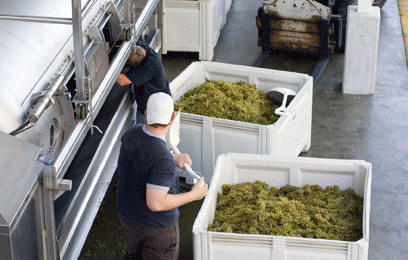
|
Published:
The wine industry embraces efficiency
The latest environmental innovation across the wine industry was a topic of discussion and comparison at the recent 2009 Winery Engineering conference held in the beautiful Barossa Valley.

|
|
Winery staff transferring a chardonnay crop for crushing. Credit: iStockphoto
|
Peter Policki, Technical Engineering Manager at Orlando Wines (the parent company for Pernod Ricard Pacific, makers of Jacob’s Creek and Wyndham Estate), says ‘Wine Delivery Automation’ has enabled his company to slash water consumption in its Jacob’s Creek winery at Rowland Flat in the Barossa by nearly 30 per cent.
At each of the main transfer points in the winemaking process – from the vineyards, to trucks, to crushing, to fermentation, to centrifuge, to blending, to filtration, to oak, and then to bottling – there is the potential to lose significant volumes of wine when it is transferred through a pipe, and then pushed out with water. By introducing an automated mobile pump to deliver the wine from the source tank to 10 bottling tanks, Orlando Wines reduced unnecessary transfers, accidental wine overflows and water consumption.
‘Waterless transfers are having a significant benefit from the point of view of both wine quality and wastewater management,’ Mr Policki said.
Michael Pecar is responsible for reducing energy and water use by 10 per cent across Foster’s Group’s 10 Australian production facilities, which includes its wineries (Wolf Blass and Lindemans) and breweries. This is no small task – based on 2007 figures, Foster’s total annual energy use was 1.74 Petajoules. One Petajoule is roughly 30 million kilowatt hours.
As Project Manager of Energy and Water Efficiency at Foster’s, Mr Pecar is searching for wasted energy (or inefficiency). At the Wolf Blass winery, he plans to apply the engineering principles of heat exchange to look more closely at the simultaneous heating of wine from a cold stabilisation state, with the cooling of wine to a cold stabilisation state, which is required for minimising sediment.
Quality Assurance Manager at Vinpac International in the Barossa, Paul Grafton, presented a case study on the successful distribution of up to 200 000 litres per day of wastewater ‘across the back fence’ to the neighbouring Adelaide Brighton Cement plant.
Vinpac, which handles wine packaging, production and distribution, produces 30 million litres of wastewater per year, but its neighbouring plant could not get enough water supply. Although the project was logistically challenging, it was environmentally and regionally sound.
All non-sewage wastewater would be stored, treated and delivered to the cement plant. Two 250 000-litre water storage tanks were built, together with other storage and treatment facilities, to ensure that Adelaide Brighton Cement received 200 000 litres per day delivered over a 10-hour period.
There were some early problems in efficiently storing such large volumes of water – odour formation from bacterial growth, and maintaining acceptable pH levels, in particular – but the water transfer now runs well.
There were plenty of other innovations presented at the conference, including quite a few clever ones from Europe that set high standards. But there was a tangible sense of Australians solving their own problems by responding to the local environment. As trade exhibitor Chris McDonald of fabric manufacturers C.E. Bartlett observed: ‘We take ideas, and we make them better.’ The Bartlett company is contributing to the green economy with environmentally friendly dam liners and haystack covers. The company illustrates the story of home-grown success built on innovation.
Orlando Wines’ Peter Policki also reflected that view about the Australian wine industry’s innovation and sustainability commitments. ‘Australians are very inventive people. They have a sense of striving for improvement and challenge conventional winemaking practices.’
‘The environment is so tough here, and the Australian approach is very positive,’ he said.
That optimism will stand the industry in particularly good stead for challenges such as climate change and its demand for adaptation.



